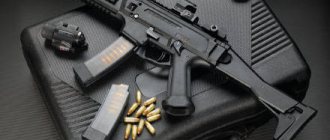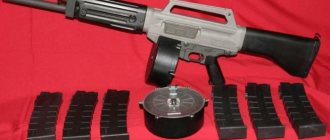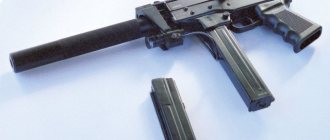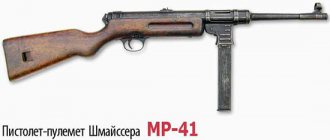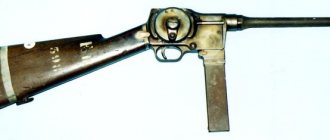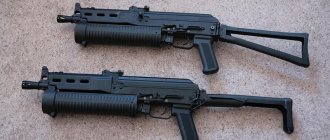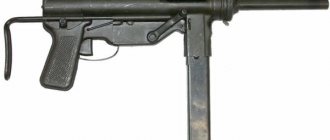Historical reference
The idea of creating a new submachine gun instead of the existing Scorpion Vz.61 arose not only in the Czech Republic, but also in Slovakia. The main reason for this was quite obvious - “Scorpio” mod. 1961 used a relatively weak pistol cartridge. This was the reason for the emergence of various modifications of weapons for a wide variety of ammunition. The best option among them was the Scorpion PP chambered for 9x19 mm.
Submachine gun CZ Scorpion EVO 3 A1
In view of this situation, in 2001, a group of enthusiastic designers began to create a new software. The weapon was created under the symbol LAUGO LTG-1. This name has a certain meaning. The word LAUGO in Latin means the abbreviated name of the city of Trencin (Laugaricio), from which the developers were, and the abbreviation LTG symbolizes the first letters of the developers' surnames (Lucansky Jan, Tverdyma Petr, Gasparik František). The first of them personally had experience in combat operations in the Balkans and had extensive knowledge in the field of small arms.
Even at the stage of design and experimental work, the PP attracted the attention of various small arms experts due to its simplicity and uniqueness. At this moment, the developers were actively looking for investors for their project, because they themselves did not have sufficient funds to develop the project. The weapon attracted the attention of the Česká Zbrojovka company. And this was an excellent incentive to speed up work on improving the submachine gun and making it one that would meet the requirements of the armed forces. At this stage, the development group was taken under the guardianship of the Slovak company ZVS, which manufactured a prototype of the PCB under the symbol LAUGO M6. The weapon was demonstrated to the public at the IDET-2005 exhibition (Brno). The PP was supposed to be produced both for the needs of the army and for civil society.
Submachine gun CZ Scorpion EVO 3 A1
2 years after the exhibition, a contract was finally signed between the developers and the Czech company Česká Zbrojovka, despite the fact that the project was not completely ready for production. Nevertheless, the company agreed to take on some obligations regarding some of the work, and made the developers themselves employees of the company.
Representatives of the police and army also took part in the development of the new Scorpion EVO 3 software, whose recommendations and wishes were accepted with particular scrupulousness.
Ultimately, the weapon was ready by 2009, and then, in May, it was demonstrated to the public at the IDET-2009 exhibition. Full development was completed in the second decade of 2009. It was then that it was given its modern name - CZ Scorpion EVO 3 A1.
Submachine gun CZ Scorpion EVO 3 A1 right view
This is interesting: the abbreviation of the weapon means the following: EVO 3 - 3rd generation PP, A1 - the first version with automatic fire mode. The single mode option is designated by the English letter S.
Scorpion Vz.61 submachine gun
Despite the very wide spread of machine guns in the second half of the twentieth century, submachine guns, which were previously virtually the only hand-held weapons with the ability to fire automatically, have not disappeared anywhere. True, the familiar appearance of the submachine gun gradually changed, which is especially noticeable when comparing World War II samples with modern ones. On the one hand, everything remains the same, it’s still the same weapon that can “spit” pistol bullets in automatic fire mode, but the layout of the weapon, its dimensions, and weight have completely changed.
It is difficult to name a specific period in years when the dimensions of submachine guns were reduced, but in general this transition occurred within ten to twenty years after the end of World War II. In fact, we can say that all post-war models reduced their size and weight due to changes in layout. This happened because machine guns seriously replaced the PP, and the weapon, which was previously the main hand-held weapon with the ability to fire automatically, became a weapon for the crews of armored vehicles, police and for combat in cramped conditions, where not only small dimensions were required, but less powerful ammunition .
In Czechoslovakia, they decided to start developing such weapons belatedly. Despite the fact that the country is famous for its gunsmiths and has always been at the forefront of its weapons, which were valued all over the world, a compact version of the submachine gun appeared only in the sixties. This delay is explained by the fact that the designers initially made a mistake and decided to create a weapon that would be quite compact and light and at the same time could fire automatically using a pistol. But the idea was a failure from the beginning, since it required a rather complex design to reduce the rate of automatic fire, and, as a result, very rapid wear of weapon parts. In addition, the ease of use of such a pistol raises a lot of questions, and successful examples of burst-firing pistols can be counted on one hand. Having seen that automatic fire in the CZ52 pistol is costly and unreliable, it was decided to curtail work in this direction and start creating a more reasonable solution to the problem, which became the Scorpion VZ61 submachine gun.
Since the time was wasted, the development of a new PP was a kind of opportunity for the designers to rehabilitate themselves, and they fully justified themselves with the new model of weapon, once again confirming that the gunsmiths in the country are among the best in the world. Even taking into account the fact that this was far from the world’s first compact version of a submachine gun, the Scorpion can be considered one of the first modern models. Even if you look at this weapon now, it is unlikely that anyone previously unfamiliar with the Scorpio will be able to say that the submachine gun is already more than half a century old. Yes, the weapon is given away by the plastic it uses, the handle with an unusual angle of ninety degrees and other individual details, but in general the weapon does not look its age and can easily be mistaken, if not for a modern model, then for a weapon from the late twentieth century is very easy. The controls of the submachine gun are thought out to the smallest detail, both from the point of view of ease of firing and from the point of view of carrying the weapon. So, despite the fact that all the controls of the SMG are quite large and convenient even for switching when the hands are protected by thick mittens or gloves, nothing in the design of the weapon digs into the body even when carried concealed. The bolt handles on both sides of the submachine gun deserve special attention; they are made in the form of small protruding elements that do not interfere at all when worn, and although it may seem that their use is not entirely convenient, you quickly get used to them and no inconvenience arises. The switch for fire modes and putting the weapon on safety is carried out using a small switch above the pistol grip of the weapon; the location of this switch is most convenient for switching with the thumb of the holding hand, although it requires sufficiently long fingers. The sights of the submachine gun are open, consist of a rear sight and a front sight, generally simple, although there are various options even with a diopter sight, which in my opinion is stupid for a submachine gun. In addition, the Scorpion submachine gun can have a wide variety of butts, including even fixed wooden ones; some samples have the ability to install an additional handle to hold the pistol when firing.
The variety of different options for the Scorpion submachine gun is not limited only to different options for stocks or sighting devices; the designers were required to constantly modernize the weapon in terms of ammunition. As it turned out, the design of the submachine gun is so successful that there is no need for deep modernization when changing the cartridge. At various times, the Scorpio submachine gun used a variety of ammunition from 7.65x17 to 9x19. In one case, such modernization was required for the weapon due to the adoption of the 9x18 cartridge; in other cases, the transition was required for the weapon to enter the world market.
This omnivorous nature of the cartridges is ensured by the fact that the designers very successfully solved the problem of reducing the rate of fire from a submachine gun. Since the automatic weapon is built according to a blowback bolt design, and the dimensions of the weapon do not allow for sufficient weight of the bolt and its long stroke, it was decided to introduce into the scheme a kind of “catcher” of the bolt in the rear position. At first glance, the bolt hook in the form of an ordinary hook is the simplest element, but everything is far from being as simple as it seems. On the surface, only the hook is exposed to public view, but it is connected to a very complex mechanism, the basis of which is inertia and springs. Having reached its rear position, the bolt not only engages with the hook, but also starts a mechanism, the result of which is the raising of the retaining hook after a very short period of time, but sufficient for the rate of fire from the submachine gun to be reduced to the required level . Very often in the description of this submachine gun you can find a few words that parts moving in a vertical plane inside the pistol grip reduce the accuracy of the weapon, and theoretically this is true. But to be honest, the small weight of moving parts, albeit moving at a very high speed, cannot create a noticeable deflection of the weapon when firing, especially for weapons where 150-200 meters to the target is the limit.
If we talk about the Scorpion Vz.61 submachine gun model itself, then it is in it that one can observe a reduction in the dimensions and weight of the weapon that the designers were striving for. The length of the submachine gun with the wire butt extended is 517 millimeters; with the butt folded, its length is only 270 millimeters, of which 115 millimeters is the barrel length. Separately, it is necessary to note such a point as the fact that firing can be carried out with one hand or with two without using a butt, that is, the weapon turned out to be really compact. Naturally, by modern standards, this model of submachine gun may not be considered the most effective, since it uses relatively weak ammunition. But, as was written above, this submachine gun developed further, the cartridge changed, individual points in the design changed, the appearance changed, and as a result of this evolution, very little remained of the first sample.
Quite often this type of submachine gun is associated with terrorist groups. Indeed, at one time this weapon quite often flashed in the hands of not the best representatives of the human race, this even to some extent contributed to the popularity of the weapon. But we should not forget that a weapon is only a means of hitting a target, and a person points a weapon at a target and shoots, therefore it is clearly wrong to associate a weapon with the goals for which it is used.
It is interesting that now Russian citizens have the opportunity to at least partially become closer to this weapon, however, in its inferior form, or rather, mutilated for a traumatic cartridge. Just a couple of years ago, a version of the submachine gun chambered for 9mm RA became available. Naturally, such a weapon is not even a means of self-defense, although it is made of a higher quality than many other types of traumatic weapons. The weapon is deprived of the ability to conduct automatic fire; its design has lost the shutter delay in the rearmost position, as this has become simply unnecessary. However, the submachine gun in its traumatic version retained the appearance of a military weapon, as well as its weight, close to the original, and the dimensions of the weapon, which pushes people to buy this model. So to speak, an MMG with the ability to fire any kind of cartridges. For the purposes of self-defense, it would be strange to recommend this weapon, since as a traumatic weapon this submachine gun has no advantage over lighter and more compact examples of traumatic pistols and revolvers.
Design features
The submachine gun is a weapon of simple design, although it consists of more than 90 parts.
The CZ Scorpion EVO 3 A1 works on the principle of using the recoil of a heavy bolt. Accurate shooting of a weapon is carried out from a closed bolt. There is a manual possibility of sending the shutter to the forward position using a special recess on its right side. The weapon has a bolt delay. The erection handle is a separate part from the bolt and can be placed either on the left side of the weapon or on the right.
Submachine gun CZ Scorpion EVO 3 A1 left view
The main parts of the submachine gun are made of high-quality and durable polymer - the receiver, barrel casing, trigger housing, butt and pistol grip. The handguard of the weapon is also plastic. This approach provided the weapon with ultra-low mass. The receiver consists of two halves, in the front of which there is a bushing.
As for the use of plastic in weapons, there is an opinion that weapons do not have sufficient durability and strength. And this is really a myth. The PP, even after firing more than 30,000 rounds in difficult conditions, did not lose its performance.
The trigger-type weapon trigger assembly is assembled separately in the housing. The upper part of the trigger body is used as a bolt guide. Fire can be carried out continuously, in bursts of 3 shots or singly. Double-sided flag switch and fuse allow you to switch the fire mode. It is located at the top of the handle. Special notches allow you to control the current mode. There is also an automatic firing pin safety lock. The solutions listed above make it possible to simplify the design as much as possible and make partial disassembly of the PCB comfortable and quite fast.
Submachine gun CZ Scorpion EVO 3 A1. Fire mode translator
The Scorpion EVO 3 sights consist of 5 Picatinny rails. Four of them are located on the forend, and one is located on the upper part of the receiver. As standard, the weapon is equipped with a diopter rear sight and an adjustable fiberglass front sight.
The weapon uses a 9 x 19 mm Luger cartridge. Double-row plastic magazines are made of transparent plastic and have a capacity of 20 or 30 rounds.
CZ Scorpion EVO 3 A1 submachine gun front view
The plastic telescopic butt of the weapon folds onto the right side. This in no way prevents us from continuing to fire. There is also the possibility of its complete separation. The pistol grip can also be adjusted horizontally. Moreover, the civilian version of the handle differs from the military one. In the first, it is not possible to install a trigger for automatic fire.
Project evaluation
As for evaluating the project, everything is clear here - this is an excellent weapon. The PP is distinguished by excellent ergonomics, low weight and excellent shooting performance.
An undoubted advantage is also the enormous rate of fire - a 30-round magazine is fired in a record time - 1.6 s. And at the moment of firing a burst, control over the weapon is not lost due to the excellent shock absorption of the bolt in the rearmost position. This is another advantage of using polymers in construction.
Submachine gun CZ Scorpion EVO 3 S1 right view
The PP is equipped with modern sighting devices; it can also be equipped with a laser sight, additional handles, a collimator sight, a tactical flashlight, and various optical sights. Why not modern weapons?
Performance characteristics
To fully understand the power of the Scorpion EVO, you need to understand all the parameters it has. Here are the criteria to consider:
- 9 by 19 millimeters Luger caliber;
- Weighs 2.895 kg with equipment (magazine with cartridges, belt, sight) and 2.45 kg without it;
- Sighting line 240 mm;
- An empty magazine has a mass of 0.1 kg, and a loaded one - 0.445 kilograms;
- The magazine holds 20, 30 rounds;
- Can fire 600 times without breaks;
- The rate of shots is 1150 per minute;
- 670 mm length of the entire weapon with the butt folded down (410 mm with the butt folded);
- 196 millimeters in height without a sight, but with a magazine;
- Inertial type of barrel bore locking;
- 60 mm wide;
- 6 grooves;
- The bullet flies at a speed of 370 m/s.
Use of weapons
At first it was believed that the weapon was created for export. But the Czech Ministry of Defense surprised the manufacturer when in the spring of 2010 it placed an order for the purchase of 572 units of PP to arm representatives of Strazhsky Grad.
This is interesting: In 2012, the Czech Zbrojovka company introduced a civilian version of the PP under the symbol CZ Scorpion EVO 3 S1.
Submachine gun CZ Scorpion EVO 3 S1 left view
There is also information that the PP is in service with the Czech army special forces and special police forces.
As for foreign operators, the CZ Scorpion EVO 3 A1 is in service with the police in Thailand and Malaysia, the law enforcement agencies of Egypt, the Philippine Coast Guard and some special forces of the Republic of Serbia.
CZ Scorpion EVO 3 A1 submachine gun for special forces
The weapon is currently produced by the company Česká Zbrojovka Uherský Brod (CZ-UB).
Weapons are also in demand in computer games - for example, in GTA V.
